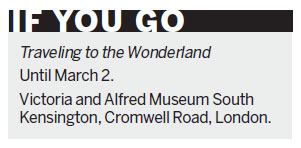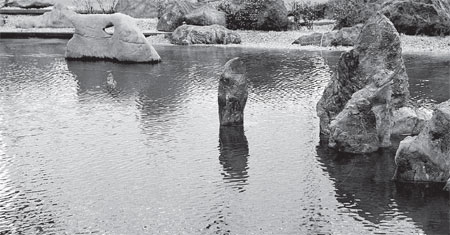Reaching for utopia
Updated: 2014-01-05 08:21
By Mariella Radaelli(China Daily)
|
|||||||
Chinese artist Xu Bing takes viewers on a journey, with a major new work in London. Mariella Radaelli reports.
Chinese artist Xu Bing celebrates the majesty of nature as the greatest force and resource given to humankind.
The pristine paradise depicted in Peach Blossom Spring by the poet Tao Yuanming (AD 365-427) resonates in Xu's major new installation, Traveling to the Wonderland, on show at the John Madejski Garden at the Victoria and Alfred Museum, London, until March 2.
The words of Tao, the pre-Tang Dynasty "poet of the fields", pulse through the ethereal landscape created by Xu, one of the most influential Chinese avant-garde artists. Xu has transformed the garden and its stone-paved oval with a surrounding water jet into a magical vision.
Xu visually evokes the text written more than 1,000 years before Thomas More's Utopia. Tao's idyllic village is a place one might only stumble upon by chance. It is hidden deep within a mountainous wilderness, where its inhabitants, protected from the outside world, live in harmony with nature.
Traveling to the Wonderland explicitly deploys elements of the Chinese utopia, and proves that the concept persists.
"I've always liked the idea of Tao Yuanming," Xu says. "I first read Peach Blossom Spring in high school, but I have continued to reread it through the years.
"Texts by ancient poets and scholars always provide me with new ideas and thoughts each time I read them.
"On the one hand, I was inspired by the water fountain at the V&A. It is a very precious spot - a kind of an oasis - in the big city. On the other, I chose this theme because I think most people don't feel that an ideal living environment exists at the present time."
When the fisherman, the protagonist of Tao's story, goes back to the village, he is unable to find the place anymore. "The route was lost. And no one ever found the way there again," Tao writes.
Xu says: "I think this symbolizes how we yearn for an ideal world that is, however, further away from us. It seems to me that a truly ideal world only exists in each person's mind, or through creative processes, like kids playing with building blocks."
Xu has produced a miniature landscape in which it seems people can live and play, but which, in reality, is impossible to enter.
"It's a space in between two-dimensional painting and reality - a 2.5-D effect," says Xu, who has created a dreamlike ambience, with mist, cute little houses and the sounds of birds and insects, along with delicate light effects.
He collected nine types of stones from five special places in China to create his site-specific installation. The biggest stone he used is about 1.8 meters high.
Xu says these stones reflect traditional Chinese painting styles and represent a close connection with nature.
"My ideal living space epitomizes harmony with nature, appreciation of everything we've been given, and gratitude for life and all its blessings. My ideal space does not destroy or change anything," he says.
Traditional crafts and techniques coexist with contemporary conceptualism in this Chongqing-born and Beijing-raised artist's pieces, and in this work he pays particular homage to ancient Chinese artists.
"Ancient Chinese artists drew inspiration from personally observing rocks and traveling in the midst of nature," Xu says.
"Put a stone on the table, and our ancestor artists could have many revelations about beauty, rhythm and the natural spirit from such simple observations. It is not a juxtaposition, but a true internal connection between Chinese traditional painting (shanshui, or landscape) and the natural environment."

Xu considers Traveling to the Wonderland his most challenging installation, in terms of methodology. He always encourages viewers to discover every possible interpretation of his art. He deliberately provokes disparate readings by playing on the multiplicity of meanings, like a poet. But Xu also resembles an engineer. His works, which combine powerful cultural icons with emotionally laden issues, are machines for generating interpretations.
"I think both poets and artists must play on the multiplicity of meanings," he says.
"I believe any good piece of art should bring people to a new place, give them a whole new experience. And every new technique used in art should bring viewers to a new place. The questions are why is it important and how to achieve it."
The concepts of transformation, regeneration and repetition play key roles in Xu's work. Asked why these aspects belong so closely to his vision, he poses a question: "How do artists inspire viewers by altering their perception, and by what method? I like to start from the most ordinary subject matter that people expect the least from. A little change to these things will trigger sufficient reaction and awareness.
"Transforming language challenges the fundamental elements of our thinking patterns, the cognitive structures of the mind."
In conjunction with the installation, Xu is also presenting Tao Yuanming's classic text through the form of his New English Calligraphy, "as an echo to my installation work", he says. The work-on-paper display related to Peach Blossom Spring is featured in Room 44 at the V&A Museum.
Contact the writer at sundayed@chinadaily.com.cn.
|
Inspired by the words of ancient poet Tao Yuanming, Xu Bing creates the installation Traveling to the Wonderland to depict Chinese utopia. Photos Provided to China Daily |
|
Xu says his ideal living space epitomizes harmony with nature |
(China Daily 01/05/2014 page4)

